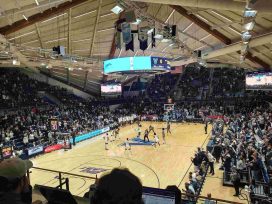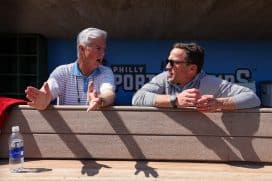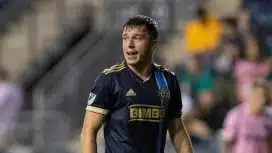Phillies
Phillies Nuggets: Why have Odubel Herrera’s defensive metrics have fallen off a cliff?
By Tim Kelly, Sports Talk Philly editor
Between 2015 and 2017, his first three years as a center fielder, Odubel Herrera graded out as the fourth best fielding center fielder in baseball. His 22.1 range runs were the third best among qualified center fielders over the same time period. One of the saving graces when Herrera's timing was off at the plate was that he was still an elite fielder in center field. Herrera appears to have broken out of one of the worst slumps of his career, one that saw his average dip from .361 on May 17 to .283 on June 16. Unlike past offensive slumps, though, Herrera's defense wasn't a saving grace during his latest slump, as his once-elite defensive metrics have taken quite the dip in his fourth year with the Phillies.
In 2017, Herrera posted a defensive WAR of 9.6, an ultimate zone rating of 7.6, a UZR/150 of 9.3 and four defensive runs saved. FanGraphs says that Herrera was the National League's third-best fielding center fielder in 2017. Through the first two and a half months of the 2018 season, Herrera has posted a defensive WAR of -1.4, an ultimate zone rating of -2.4, -5.2 UZR/150 and -3 defensive runs saved. FanGraphs says Herrera has been the 17th best fielding center fielder thus far in 2018.
Two and a half months don't define someone in the field. Herrera's had a rather remarkable start to his career in the outfield considering that when the Phillies selected him in the Rule-5 Draft in December of 2014, he was a natural second baseman who appeared to lack a position. But his defensive metrics have taken a rather alarming dip in 2018, one worth further investigation.
Jim Thome: Watching 2008 Phillies Was Like Seeing Your Brothers Win
Perhaps the most notable difference about Herrera's fielding in 2018 is his starting position. Baseball Savant's average staring fielder position tool says that in 2017, the average starting position of a center fielder was 317 feet away from home plate. Herrera's average starting position in center field was 318 feet, which was 55th among center fielders that the tool measured. In 2018, the average center fielder is starting plays 316 feet away from home plate. However, under a new, more analytically inclined coaching staff, Herrera's average starting position in center field is 324 feet from home plate. He's gone from being the 55th furthest center fielder away from home plate in 2017 to the seventh closest in 2018. Could eight feet be making that much of an impact on Herrera's success in center field? It appears to be having some impact.
Defensive positioning, of course, isn't limited to just north-south, but also east-west. Under Gabe Kapler, the Phillies are shifting at a much higher rate than they did under Pete Mackanin. A season ago, the Phillies shifted 19.2 percent of the time against left-handed hitters and 6.2 percent of the time against right-handed hitters. The Phillies actually utilized shifts at the 11th highest rate in the league a year ago, but they've still seen a dramatic increase in 2018. Against left-handed hitters, the Phillies are shifting 42.9 percent of the time. Against right-handed hitters, the Phillies are shifting 11.1 percent of the time. For reference, the league average of shift percentage against left-handed hitters is 30.1 percent and 8.5 percent against right-handed hitters.
It's difficult to quantify the exact effect that the Phillies dramatic increase of shift utilization has had on Herrera. Heck, it's difficult to quantify defense period. There's two different takeaways that one could have regarding how Herrera's defensive metrics have declined as the Phillies have shifted more. The first is that Herrera isn't fielding well, but it's because the Phillies shifts aren't putting him in proper position to have success. Jake Arrieta may be sympathetic to that argument. The other possible takeaway is that while Herrera may not be fielding as well as he typically has, some of the statistics we are using to grade the defensive success of outfielders – statistics that seemed "ahead of the curve" just a few years ago – are no longer as useful. As The Athletic's Ben Harris pointed out earlier this month, defensive runs saved doesn't factor in shifts, making it hard to trust if the Phillies are shifting over 40 percent of the time when facing left-handed pitchers.
From a more traditional perspective, one could ponder the effect that playing in an outfield without outfielders who traditionally grade out well as fielders has had on Herrera. Nick Williams has never graded out well as a fielder. Aaron Altherr, despite tremendous athleticism, has a -3.3 defensive WAR in 2018 and a -7.7 career defensive WAR. Rhys Hoskins, of course, is a natural first baseman that's playing in left field because the Phillies signed Carlos Santana in the offseason. (Truth be told, Hoskins probably wouldn't grade out well at any position defensively.) So Herrera's a traditionally elite fielder surrounded by fielders who traditionally haven't been graded out well.
Related: Phillies Reportedly Willing To Accommodate Manny Machado By Playing Him At SS
The problem with that theory is that Herrera graded out well playing around those same three outfielders for portions of the 2017 season. He graded out well as a fielder when Cody Asche, Ben Revere, Domonic Brown and Darin Ruf – none of whom graded out well as fielders – were playing in corner outfield positions aside of him.
Even in an age where advanced information is readily accessible to the general public, that information doesn't always lead to a clear answer. Is there a correlation between Herrera's starting position in center field moving back eight feet between 2017 and 2018 and his metrics dipping? Probably. The same can be said for his metrics slipping as the Phillies shift more. But at this moment, there isn't one specific thing that can be pointed to as the explanation for why his defensive metrics have slipped so much in 2018. It's something worth monitoring throughout the rest of the 2018 campaign.
SportsTalkPhilly.com's Jason Ferrie (@JFerrie23) contributed to this article.












































